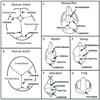Models of cranial suture biology
- PMID: 23154351
- PMCID: PMC4126807
- DOI: 10.1097/SCS.0b013e318258ba53
Models of cranial suture biology
Abstract
Craniosynostosis is a common congenital defect caused by premature fusion of cranial sutures. The severe morphologic abnormalities and cognitive deficits resulting from craniosynostosis and the potential morbidity of surgical correction espouse the need for a deeper understanding of the complex etiology for this condition. Work in animal models for the past 20 years has been pivotal in advancing our understanding of normal suture biology and elucidating pathologic disease mechanisms. This article provides an overview of milestone studies in suture development, embryonic origins, and signaling mechanisms from an array of animal models including transgenic mice, rats, rabbits, fetal sheep, zebrafish, and frogs. This work contributes to an ongoing effort toward continued development of novel treatment strategies.
Figures
References
-
- Opperman LA. Cranial sutures as intramembranous bone growth sites. Dev Dyn. 2000;219:472–485. - PubMed
-
- Weinzweig J, Kirschner RE, Farley A, et al. Metopic synostosis: Defining the temporal sequence of normal suture fusion and differentiating it from synostosis on the basis of computed tomography images. Plastic and reconstructive surgery. 2003;112:1211–1218. - PubMed
-
- Panchal J, Uttchin V. Management of craniosynostosis. Plastic and reconstructive surgery. 2003;111:2032–2048. - PubMed
-
- Whitaker LA, Bartlett SP, Schut L, et al. Craniosynostosis: an analysis of the timing, treatment, and complications in 164 consecutive patients. Plast Reconstr Surg. 1987;80:195–212. - PubMed
Publication types
MeSH terms
Substances
Grants and funding
LinkOut - more resources
Full Text Sources
Miscellaneous


